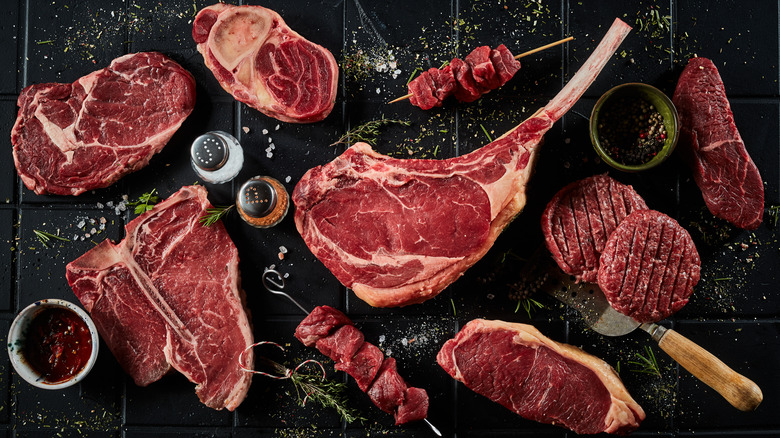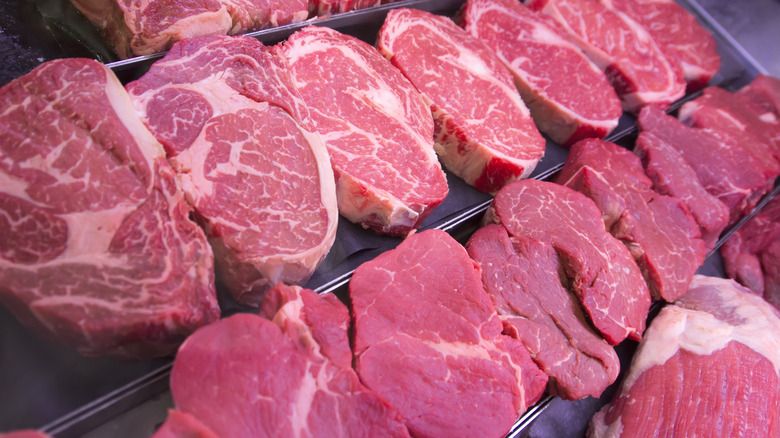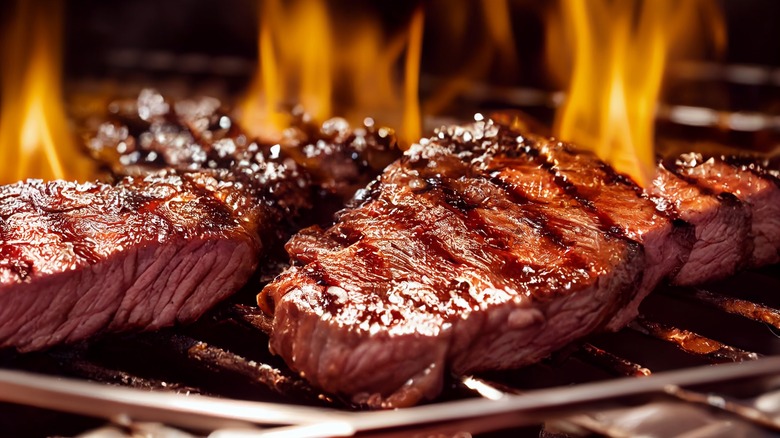Not Every Cut Of Beef Is A Steak. Here's Why
If you've ever peeked in a butcher's case, you know that not every piece inside is regarded as "steak," but what is the factor separating those from other beef cuts? In truth, it's a little bit complicated. Merriam-Webster will tell you that a steak is "a slice of meat cut from a fleshy part of a beef carcass." To get even more specific, steaks are also usually thick, sliced against the grain, and intended to serve one person. Many of the most popular steaks, including filet mignon, ribeye, T-bone, and strip steak fit this classical definition.
But there are exceptions. Flank steak and skirt steak are large, flat portions of beef with the grain intact that are not sliced until after cooking, and are often big enough to feed a group. Ground meat that is formed into the shape of a steak can also count (as in cube steak), a notion bolstered by the judgment of a suit filed against Dunkin' for one of its breakfast sandwiches.
Furthermore, not every steak is a cut of beef, as the term can also apply to thick slices of fish or vegetables like cauliflower. There's a lot of variation there, so for the purposes of beef, it might be more helpful to define different cuts based on what stage of the butchering process they come from.
The finer points of butchering
Butchering a cow happens in stages. First, the carcass is divided into eight large pieces known as primal cuts, which include the ribs, chuck, and brisket. In the second stage of butchering, these primal cuts are broken down into smaller segments known as subprimal cuts. Subprimals include the cuts that we refer to as "roasts" — large pieces of beef big enough to feed a family. When you cut a subprimal into even smaller portions, you get steaks.
Most steaks are just sliced versions of roasts. For example, a filet mignon is simply a thick slice of a beef tenderloin, and a ribeye steak is sliced from a prime rib. The most popular steaks typically come from primal cuts located along the cow's back, like the ribs and loin, because those muscles don't work out a lot and thus make for very tender meat. However, there are exceptions. The plate primal cut, located near the cow's belly, is the source of popular cuts like hanger steak and skirt steak, and the flank primal cut, found just behind the plate is almost exclusively used for flank steak.
Cooking steaks vs. other cuts of beef
Steaks are also defined by how we cook them, which stands out from most other cuts of beef. Since steaks are generally the smallest type of beef cut, they don't need to cook for long. They are best suited to high-and-fast cooking methods like grilling or searing in a cast-iron pan, which will ensure a nice crust forms on the steak before the inside overcooks.
Outside of steaks, most other types of beef cuts don't do well on the grill or other quick high-temp methods. Larger subprimals like roasts and rib racks should be slow-cooked instead. Since they have not been trimmed down as much as steaks, they often have more tough fat and connective tissue to tackle, and slow-cooking methods like braising a pot roast or making a stew, which use additional liquid to help ensure tenderness, are the best options for these larger cuts of beef.


